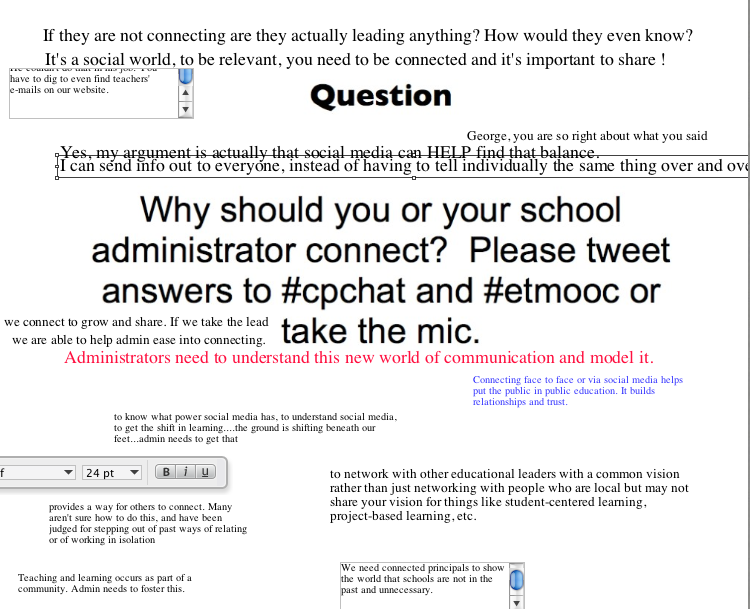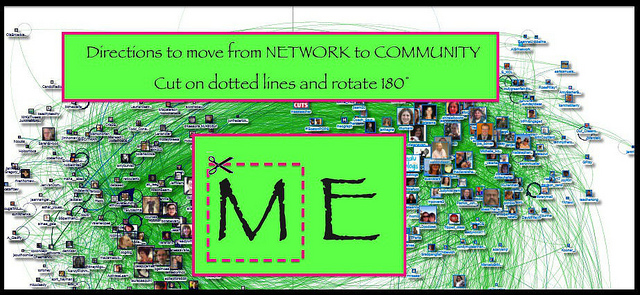We were challenged to answer a few questions this week during the Connected Learning module in #ETMOOC.
One question is “What does my PLE/PLN look like? How can I share it?”
First of all, I had to look up PLE because I had forgotten what it meant. (It’s personal learning environment). I knew PLN — personal or professional learning network. I guess I use these terms interchangeably. My connected learning is professional (it’s all about education) and personal (I choose who and the trails to follow in my learning journey).
This week, though, Ben Wilkoff offered another name for PLN — a personal or professional learning neighborhood. That makes complete sense to me now. After building my PLN for a couple years, I find my most meaningful connections are going deeper.
I have a small eclectic neighborhood that started with the Kick Start Your Blogging Teacher Challenge two years ago. The friends I made through #ksyb were my first tentative connections, and many of them continue today: Nancy Carroll, Theresa Allen, Tracy Watanabe, Malyn Mawby, Karla O, Tracey Smith, Kathryn Trask and Sheri Edwards.
Now I also have a genius hour neighborhood. Gallit Zvi, Joy Kirr, Hugh McDonald, Robyn Thiessen, Sheri Edwards, Beverley Bunker, Jodi Pulvers, Karen Lirenman, Valerie Lees, A.J. Juliani, Julie Jee, and it continues to grow. Here are more genius hour teachers on my Genius Hour Twitter List.
I have a middle school educator neighborhood, including Laura Coughlin, Joy Kirr, Krissy Venosdale, Scott Boylen, Michelle T.G., Kay McGriff, JoAnn Jacobs. And Sheri Edwards. Again. Thanks to her and #etmooc, this neighborhood is growing, more intentionally growing. I’ve met Lorraine Boulos, Scott Hazeu, and Allison Petersen as a result. This middle school neighborhood has a wiki called Connect in the Middle and a Diigo group. It’s a collaboration place for middle school educators. And you are welcome to join too.
Some questions I am just attempting to answer during #etmooc…
- How important is connected learning? Why?
Off the top of my head, last night I said connected learning is great for modeling lifelong learning and expanding our world view. It’s so true. I can’t explain it, but it is doing both those things for me. It is a way to make my learning visible.
Administrators and teachers should be connected so they model lifelong learning & broaden their world view. #cpchat #etmooc
— Denise Krebs (@mrsdkrebs) January 30, 2013
In the #etmooc session on leadership (scroll down to T1S6), participants gave more reasons for being connected:

One of my favorite reasons was articulated well by Bernard (that’s all I know of who he is). “We network by passion rather than proximity.” I love that I have a professional learning environment that includes teachers down the hall like Brenda Ortmann and Kristine Full, but also in Missouri, Illinois, Washington, British Columbia, New Zealand, and more. I learn from many people who push me to greater accomplishments and who share my passions. I don’t have to rely only on those who share my proximity.
We network by passion rather than proximity. Wonderful way to describe it, Bernard. #etmooc #cpchat
— Denise Krebs (@mrsdkrebs) January 30, 2013
- Is it possible for our classrooms to support connected learning? If so, how?
I am lucky to have access to MacBook Pros in my classroom, so my students are able to be connected with their own Google Apps and Edublogs accounts. These and programs such as Skype and Twitter have been invaluable in our quest for connected learning. However, many teachers and students are connected without a lot of technological support. Sheri wrote a recent blog post about how to connect with limited technology.
- What skills and literacies are necessary for connected learning? How do we develop these?
- Of course, basic literacy skills are more important than ever. Critical thinking and reading are imperative to navigate through the sea of information. Good communication with others we are connecting with requires listening, speaking, reading, and writing.
- Digital literacy – The basics of digital learning, being comfortable navigating around device(s). We develop digital literacy by the messiness of doing, patiently troubleshooting and working in our digital spaces. Here is where students and teachers learn together. I don’t think it is really about digital natives and digital immigrants; it’s about daring to click, grabbing hold of the device and figuring it out. Young and old must learn to do this.
- Digital fluency – Recently I’ve heard Mitch Resnick and Alec Couros talk about digital fluency. I see fluency as going beyond the basics of digital literacy to become well-versed, able to learn on your own, to tackle new problems and not give up. Fluency is the ability to create content and navigate effectively in the online world.
- Heutagogy, or self-determined learning. Perhaps this is also known as rhizomatic learning. Or are they different? (I don’t know yet.) More and more, learning is and will be self-determined.
- Of course, basic literacy skills are more important than ever. Critical thinking and reading are imperative to navigate through the sea of information. Good communication with others we are connecting with requires listening, speaking, reading, and writing.
I made a Voicethread trying to share a little of my journey from just using technology to becoming a connected educator.

